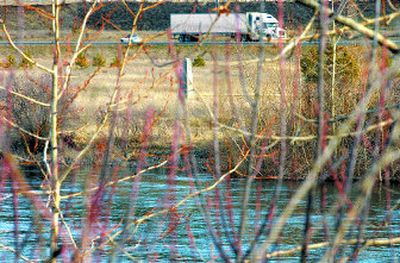Marker recalls 1858 slaughter of horses

On the south bank of the Spokane River, just two miles west of the Washington-Idaho state line, stands a monument to 800 horses slaughtered by the U.S. Army.
The interstate runs within a few hundred yards of it. The relentless moan of tractor-trailers and commuter cars plays a lonely soundtrack. The Centennial Trail practically brushes against the 8-foot granite slab.
But few people stop to read its roughly sterile account of how Col. George Wright, with superior howitzers and rifles, twice outgunned local Indian tribes then led his troops to this area where, on Sept. 9, 1858, roughly 800 horses were killed “to prevent the Indians from waging further warfare.”
But there is more to the story than is etched in stone, more pain than could be conveyed by the warrior sandblasted into the granite face, his broad shoulders slumped in defeat, his long, downward-pointing spear pulling at his arms as if it has become too heavy to raise.
Wright, credited with bringing Eastern Washington under white control, broke the tribes with what he later called an 80-mile route “marked by slaughter and devastation.” His personal account of the event is spelled out in the “History of Pacific Northwest – Oregon and Washington, Volume 1.”
Wright had been dispatched from Walla Walla with 700 men to wage war against the Palouse, Spokane, Coeur d’Alene and Yakama tribes, which earlier that year near present-day Rosalia had defeated 152 enlisted men led by Lt. Col. Edward Steptoe. Steptoe had been called to Colville because Hudson’s Bay Company workers there feared attack and because two white miners were reportedly killed in the upper Snake River area, even though the Army prohibited white travel in the area.
Better armed than Steptoe, Wright defeated the Indians at Four Lakes and on the Spokane Plains, then marched toward Cataldo, destroying everything in his path. In his Army journal, Wright wrote that he ordered his men to burn every Indian lodge and every storehouse of winter supplies they came across. They hacked up livestock and mostly left the meat to rot. Then they rounded up 800 horses in the mountains near present-day Liberty Lake.
Slaughtering the animals took a couple of days. Soldiers pinned the herd against the steep slopes of the north bank, then led small groups of horses to a gravel bar to be shot.
Wright would later explain the horse slaughter to Cataldo Jesuits as payback to Palouse Chief Tilcoax, who the colonel said stole the animals from the government and settlers in Walla Walla Valley. He characterized the entire mission as punitive.
“A blow has been struck that they will never forget,” the colonel said.
But sending Indians into winter on foot with no food stores went beyond punishment, said Frank SiJohn, a Coeur d’Alene Indian who has devoted much of his later life to preserving and authenticating the oral history of his people. Nor was it likely that many horses belonged to one man.
“It was no punitive campaign. It was … search and destroy,” said SiJohn, “It created a lot of animosity and anger. Warrior to warrior, we would fight you, but you did not hurt our families and our elders.”
What’s more likely, said SiJohn, is that the animals belonged to several hundred Indians, because every warrior’s family needed a horse for fighting, a packhorse, a horse for family. Indians on the upper Snake River had been raising horses for 170 years before Wright arrived.
Horses carried them to the spring salmon run on the Spokane River, to the Palouse for bitterroot and camas, and to Clark Fork to pick huckleberries. Horses brought them back to the outlet of Coeur d’Alene, where they’d winter.
The loss was keenly understood by the generation of SiJohn’s father, Isaac. Isaac was a child growing up in Lovelle Valley south of Plummer, Idaho, during the second decade of the 20th century. Indians in Lovelle Valley still made the 100-plus mile trek to Clark Fork for huckleberries.
The SiJohn family traveled by horse-drawn wagon, which could take six days. And when they broke out of the mountains to cross the Spokane River, they would catch the unmistakable glare of Wright’s handiwork, bleached bones cooked by the sun and spread over such a wide area that from a high point you could see the killing grounds from miles away.
“They would come out near Post Falls and look down on the flats, and they could see the white, parched bones. It looked like a white lake,” Frank SiJohn said. “That’s the Indian name for it: White Lake.”
Last Friday, fat spring snowflakes fell around the base of the monument, quickly covering the ground. It would have been easy to evoke White Lake’s tragic image, but no one did. The high-pitched moan of the highway faded to a wet hiss as thousands of people continued driving by unaware.